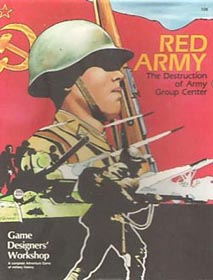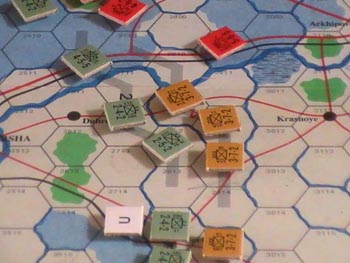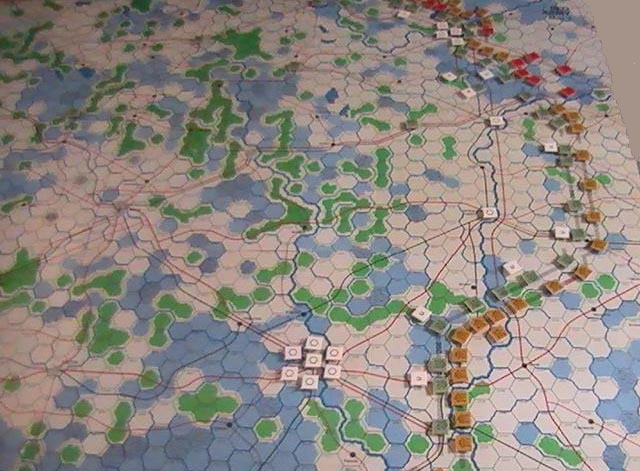Operation
Bagration
Operation
Bagration (Operatsiya Bagration) was the codename for the Soviet 1944 Belorussian
Strategic Offensive Operation during World War II, which cleared German forces
from the Belorussian SSR and eastern Poland between 22 June 1944 and 19 August
1944.The operation was named after 18th–19th century Georgian Prince Pyotr
Bagration, general of the Russian army who received a mortal wound at the Battle
of Borodino. The Soviet armies directly involved in Operation Bagration were the
1st Baltic Front under Army General Hovhannes Bagramyan, the 1st Belorussian Front
commanded by Army General Konstantin Rokossovsky, who was promoted to Marshal
on June 29, 1944, the 2nd Belorussian Front commanded by Colonel-General G. F.
Zakharov, and the 3rd Belorussian Front commanded by Colonel-General Ivan Chernyakhovsky.
This action resulted in the almost complete destruction of the German Army Group
Centre and three of its component armies: Fourth Army, Third Panzer Army and Ninth
Army. The operation "was the most calamitous defeat of all the German armed
forces in World War II". By the end of the operation most of the western
Soviet Union had been liberated and the Red Army had achieved footholds in Romania
and Poland.The objectives
of the operation are more complicated. The Red Army practiced the concept of Soviet
Deep Operations, Soviet Deep Battle and Maskirovka, (military deception). It has
been suggested the primary target of the Soviet offensive was bridgehead on the
Vistula river in central Poland, and that Operation Bagration was to create a
crisis in Belorussia to divert German mobile reserves to the central sectors as
a part of Maskirovka, removing them from the Lublin-Brest, Lvov-Sandomierz area
area where the Soviets intended to undertake the Lvov–Sandomierz Offensive
and Lublin-Brest Offensive. This allowed the Red Army to reach the Vistula river
and Warsaw, which in turn put Soviet forces within striking distance of Berlin,
conforming to the concept of Soviet deep operations - striking deep into the enemy's
strategic depths.
Army Group Centre had previously proved tough to defeat
as the Soviet defeat in Operation Mars had shown. But by June 1944, despite shortening
its front line, it had been exposed following the severe defeats of Army Group
South in the battles that followed the Battle of Kursk, the Liberation of Kiev
and the Liberation of the Crimea in the late summer, autumn and winter of 1943–44—the
soviet-called third period of the Great Patriotic War. Operation Suvorov had seen
Army Group Centre itself forced to retreat westwards from Smolensk during the
autumn of 1943.
Background
By
the middle of June 1944 the Western Allies on the Cotentin Peninsula were just
over 1046 km (650 miles) from Berlin, while the Soviet forces at the Vitebsk Gate
were within 1200 km (745 miles) of the German capital. For the Third Reich the
strategic threats were about the same. Hitler underestimated the threat posed
by Soviet troops facing Army Group Centre and had redeployed one third of Army
Group Centre's artillery, half their tank destroyers and 88 percent of their tanks
to the Southern front where the German high command expected the next major Soviet
offensive. Bagration,
in combination with the neighbouring Lvov-Sandomierz Offensive launched a few
weeks later in Ukraine, allowed the Soviet Union to recapture Belorussia and the
Ukraine within its 1941 borders, advance into German East Prussia, but more importantly,
the Lvov-Sandomierz operation allowed the Red Army to reach the outskirts of Warsaw
after gaining control of Poland east of the Vistula river. The operation enabled
the next operation, Vistula–Oder Offensive, to come within sight of the German
capital. The Soviets were initially surprised at their success of the Belorussian
operation which had nearly reached Warsaw. The Soviet advance encouraged the Warsaw
uprising against the German occupation forces. This enabled Joseph Stalin to destroy,
indirectly, his enemies in Poland by allowing the Germans to crush the uprising.
Stalin was irritated by the military success in the central sector as it forced
him to reveal more of his post war intent earlier than he would have liked. The
battle has been described as the triumph of the Soviet theory of "the operational
art" because of the complete co-ordination of all the Strategic Front movements
and signals traffic to fool the enemy about the target of the offensive. The military
tactical operations of the Red Army successfully avoided the mobile reserves of
the Wehrmacht and continually "wrong-footed" the German forces. Despite
the huge forces involved, Soviet front commanders left their adversaries completely
confused about the main axis of attack until it was too late.
Above
text courtesy of Wikipedia |


